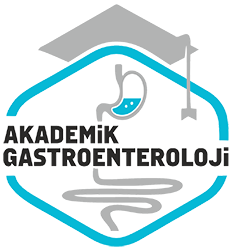Aralik 2021
Spontan bakteriyel peritonitli hastalarda hastane içi mortaliteyi etkileyen faktörler
Factors affecting in-hospital mortality in patients with spontaneous bacterial peritonitis
- Ana Sayfa
- Sayılar
- Aralik 2021
- Spontan bakteriyel peritonitli hastalarda hastane içi mortaliteyi etkileyen faktörler...
Özet
Giriş ve Amaç: Spontan bakteriyel peritonit, dekompanse karaciger sirozunun sik görülen ve mortalitesi yüksek bir komplikasyonudur. Bu çalışmada spontan bakteriyel peritonitli sirotik hastalarda hastane içi mortaliteyi etkileyen faktörlerin saptanmasi amaçlandi. Gereç ve Yöntem: Hastanemiz Gastroenteroloji Klinigi’nde 5 yıllik periyot içinde hastanede yatan 129 sirotik hasta ve bu hastalarda gelişen 151 spontan bakteriyel peritonit epizodu retrospektif olarak değerlendirildi. Tüm Hastaların demografik özellikleri, laboratuvar parametreleri, asit mayi tetkikleri, Child-Turcotte-Pugh, son dönem karaciger hastalığı modeli, sodyum-son dönem karaciger hastalığı modeli skorlari, siroz komplikasyonlari incelendi ve sag kalan grup ile exitus olan grup bu parametreler yönünden karsilastirildi. Bulgular: Hastaların %57.3’ü (n = 74) erkek ve %42.7’si (n = 55) kadındi, yaş ortalaması 60.4 ± 12.7 yıl (20 - 90) olarak bulundu. Hastalarda En sık siroz nedeni %32.6 orani ile hepatit B virüsü idi. Hastaların %41.7’si Child-Turcotte-Pugh B ve %58.3’ü Child-Turcotte-Pugh-C evresinde idi. Child-Turcotte-Pugh C evresinde hastane içi mortalite orani Child-Turcotte-Pugh B evresinde göre anlamli olarak yüksekti (p = 0.01). Exitus olan grupta lökosit ve nötrofil sayisi, kan üre azotu, bilirübin, uluslararasi normallestirilmis oran değeri ve asit mayi lökosit ve nötrofil sayisi sag kalan gruba göre daha yüksek saptandi (p < 0.001). Child-Turcotte-Pugh, son dönem karaciger hastalığı modeli ve sodyum-son dönem karaciger hastalığı modeli skorunun hastane içi mortalite ile ilişkili olduğu ve son dönem karaciger hastalığı modeli skorunun hastane içi mortaliteyi öngörmede sodyum son dönem karaciger hastalığı modeli ve Child-Turcotte-Pugh skorundan daha üstün olduğu bulundu (p < 0.001). Böbrek yetmezligi gelişen hastalarda hastane içi mortalite orani daha yüksekti (%52.7’ye karsi %12.5; p < 0.001). Hepatik ensefalopati (%48.9’a karsi %17.3; p < 0.001), hepatorenal sendrom (%85.7’ye karsi %13.8; p < 0.001) ve diğer enfeksiyonlarin gelisimi (%48.5’e karsi %21.2; p = 0.003) ile hastane içi mortalite arasında anlamli ilişki saptandi. Sonuç: Spontan bakteriyel peritonitli hastalarda lökosit ve nötrofil yüksekligi, kan üre azotu, bilirübin, uluslararasi normallestirilmis oran, asit mayi lökosit ve asit mayi nötrofil sayisi yüksekligi hastane içi mortaliteyi olumsuz yönde etkilemektedir. Hastalarda böbrek yetmezligi gelisimi, asit mayi kültür pozitifliği, hepat ik ensefalopati, hepatorenal sendrom ve enfeksiyon gelisimi hastane içi mortaliteyi arttirmaktadır. Skorlama sistemlerinden son dönem karaciger hastalığı modeli skoru, hastane içi mortaliteyi öngörmede sodyum-son dönem karaciger hastalığı modeli ve Child-Turcotte-Pugh skorundan daha üstündür.
Abstract
Background and Aims: Spontaneous bacterial peritonitis is a common complication of decompensated liver cirrhosis with a high mortality rate. The aim of this study was to determine the factors affecting in-hospital mortality in cirrhotic patients with spontaneous bacterial peritonitis. Materilas and Method: 129 patients with cirrhosis who were hospitalized in the Gastroenterology Clinic of our Hospital within a 5 year period and 151 episodes of spontaneous bacterial peritonitis developed in these patients were evaluated retrospectively. Demographic characteristics, laboratory parameters, ascitic fluid tests, Child-Turcotte-Pugh, Model for End-stage Liver Disease, sodium-Model for End-stage Liver Disease scores, complications of cirrhosis were examined in all patients, and the surviving group and the exitus group were compared in terms of these parameters. Results: Of the patients, 57.3% (n = 74) were male and 42.7% (n = 55) were female. The mean age of the patients was 60.4 ± 12.7 (20-90). Hepatitis B virus was the most common cause of cirrhosis with a rate of 32.6%. Cirrhosis stage was Child C and Child B in 58.3% and in 41.7% of the patients respectively. In-hospital mortality rate was significantly higher in patients with Child B cirrhosis stage than those with Child C (p = 0.01). The leukocyte and neutrophil counts, blood urea nitrogen, bilirubin, international normalised ratio values and ascites leukocyte and neutrophil counts were found to be higher in the exitus group than the surviving group (p < 0.001). It was found that Child-Turcotte-Pugh, Model for End-stage Liver Disease and sodium-Model for End-stage Liver Disease scores were associated with in-hospital mortality, and Model for End-stage Liver Disease score was superior to sodium-Model for End-stage Liver Disease and Child-Turcotte-Pugh scores in predicting in-hospital mortality (p < 0.001). In-hospital mortality rate was higher in patients who developed relationship between in-hospital mortality and hepatic encephalopathy (48.9% vs. 17.3%; p < 0.001), hepatorenal syndrome (85.7% vs. 13.8%; p < 0.001), and the development of infections other than spontaneous bacterial peritonitis (48% vs. %21,2; p = 0.003). Conclusion: In patients with spontaneous bacterial peritonitis, elevated leukocytes and neutrophils, high blood urea nitrogen, bilirubin, international normalised ratio values, and high ascitic leukocytes and ascitic fluid neutrophil counts affect in-hospital mortality negatively. Development of renal failure, positive culture of ascitic fluid, hepatic encephalopathy, hepatorenal syndrome and infection other than spontaneous bacterial peritonitis increase in-hospital mortality. Of the scoring systems, the Model for End-stage Liver Disease score is superior to the sodium-Model for End-stage Liver Disease and Child-Turcotte-Pugh score in predicting in-hospital mortality.



